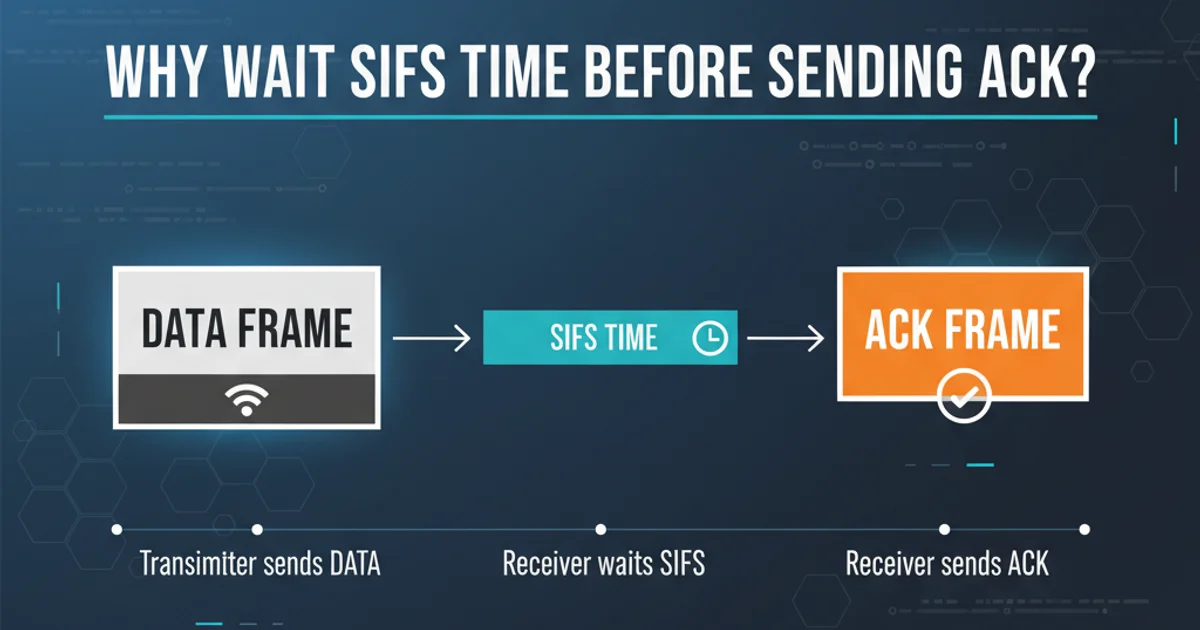Why wait SIFS time before sending ACK?
Categories:
Understanding SIFS Time in Wi-Fi: Why ACK Waits

Explore the critical role of Short Interframe Space (SIFS) in Wi-Fi protocols, specifically why an ACK frame must wait for SIFS before transmission to ensure efficient and collision-free communication.
In the complex world of wireless communication, particularly Wi-Fi (IEEE 802.11), timing is everything. To ensure reliable data delivery and prevent collisions on a shared medium, various interframe spaces (IFS) are defined. Among these, the Short Interframe Space (SIFS) plays a crucial role, especially in the immediate acknowledgment (ACK) mechanism. This article delves into why an ACK frame must wait for SIFS time before being sent, and how this seemingly small delay is fundamental to the efficiency and robustness of Wi-Fi networks.
The Role of Interframe Spaces (IFS) in Wi-Fi
Wi-Fi uses different interframe spaces to prioritize access to the wireless medium and manage the flow of data. These spaces are essentially mandatory idle periods that a station must observe before transmitting. The primary IFS types include:
- Short Interframe Space (SIFS): The shortest IFS, used for high-priority transmissions like ACKs, CTS, RTS, and fragment bursts.
- Distributed Interframe Space (DIFS): A longer IFS, used by stations initiating a new data transmission.
- Extended Interframe Space (EIFS): Used when a station detects an error in a received frame.
These different timings help in creating a structured access method, preventing simultaneous transmissions and ensuring that critical control frames get priority.
sequenceDiagram
participant Sender
participant Receiver
Sender->>Receiver: Data Frame
Note over Receiver: Receiver processes Data Frame
activate Receiver
Receiver-->>Receiver: Wait SIFS
deactivate Receiver
Receiver->>Sender: ACK Frame
Note over Sender: Sender receives ACK, confirms deliverySequence of Data and ACK Transmission with SIFS
Why SIFS for ACK? Ensuring Immediate Response and Priority
The primary reason an ACK frame must wait for SIFS time is to give it the highest priority for medium access. After a station successfully receives a data frame, it needs to send an acknowledgment (ACK) back to the sender to confirm receipt. This ACK is critical for the sender to know if the data arrived safely and if retransmission is necessary.
By mandating a SIFS wait for ACK frames, the IEEE 802.11 standard ensures that:
- Immediate Response: The ACK can be sent almost immediately after the data frame is received, minimizing the time the sender has to wait for confirmation.
- Priority over New Data: SIFS is shorter than DIFS. This means that any station that wants to initiate a new data transmission must wait for DIFS, which is longer than SIFS. Consequently, the ACK frame, waiting only SIFS, will gain access to the medium before any new data transmission can begin. This prevents new data from colliding with the expected ACK.
- Collision Avoidance: If multiple stations were allowed to transmit immediately without any interframe space, collisions would be rampant. SIFS provides a minimal, yet crucial, buffer that allows the receiving station to prepare and send its ACK without interference from other stations attempting to access the medium for new transmissions.
- Reliable Data Transfer: This mechanism is fundamental to the reliability of Wi-Fi. Without a prioritized ACK, senders would frequently time out and retransmit data, leading to significant inefficiency and reduced throughput.
Impact on Network Performance
The SIFS mechanism, while introducing a tiny delay, significantly improves overall network performance and reliability. Without it, the collision rate would increase dramatically, leading to more retransmissions, higher latency, and lower effective throughput. This structured approach to medium access is a cornerstone of the Carrier Sense Multiple Access with Collision Avoidance (CSMA/CA) protocol used in Wi-Fi.
Understanding SIFS is key to comprehending how Wi-Fi networks manage shared access and ensure robust data delivery in a dynamic wireless environment. It's a testament to the meticulous design of the 802.11 standard that such a small timing detail has such a profound impact on network stability and efficiency.